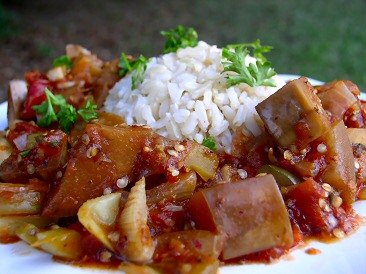Pineapple Coffee Cake
"This recipe was tested on animals."
That was my daughter's way of admitting that she had been feeding the cat pieces of cake under the table. I laughed so hard I nearly choked on my own cake. E. has picked up enough from me to know that I think animal testing is a bad thing, so she assured me that the cat liked the cake and therefore wasn't hurt by the testing.
We were celebrating my husband's birthday with pineapple coffee cake and Equal Exchange French Vanilla coffee (E. had chocolate soymilk). I consider myself a lucky woman to have a husband who not only is kind, loving, and smart as hell but also has a relatively small sweet tooth and doesn't mind having a birthday cake that's just as good for him as it is good. Not only is this cake completely free of added fats, it also uses only whole wheat and oat flour--no white flour at all--and contains very little sugar. It's a dense cake without being heavy, and the sprinkling of sugar on top gives it a sweet crunch. I strongly recommend using a coarse sugar such as demerara or raw sugar for the topping--it keeps its shape during baking and provides that crunch.

Pineapple Coffee Cake
(click for printer-friendly version)
Dry Ingredients:
1 cup quick or whole oats (not instant)
1 cup whole wheat flour
1/2 cup vegan sugar (I used demerara)
2 teaspoons baking powder
1 1/2 teaspoons Ener-G Egg Replacer
1/2 teaspoon ground cinnamon
1/2 teaspoon baking soda
1/2 teaspoon salt
Wet Ingredients:
3 tablespoons water
1 tablespoon white or cider vinegar
1 cup crushed pineapple packed in pineapple juice, undrained
1/3 cup unsweetened applesauce
Topping:
2 tablespoons coarse sugar, such as demerara or raw sugar
1/2 teaspoon cinnamon
Preheat the oven to 350 F. Lightly spray or wipe the bottom and sides of a 8 X 8-inch glass baking pan with oil or cooking spray. (You may use metal, but the baking time will vary.)
Put the oats into a blender and grind until they are fine. Stir a couple of times to make sure that they're uniformly ground.
Mix the oat flour with the other dry ingredients. Add the wet ingredients and stir until moistened and completely combined, but don't overmix. Pour into the prepared pan (batter will be thick). Mix together the sugar and cinnamon topping, and sprinkle it over the top.
Bake for 30-40 minutes, until a toothpick inserted in the middle comes out clean. Allow to cool for at least 15 minutes. Eat and celebrate!
Makes about 9 pieces. Each piece contains: 155 Calories (kcal); 1 g Total Fat; (4% calories from fat); 3 g Protein; 36 g Carbohydrate; 0 mg Cholesterol; 299 mg Sodium; 3 g Fiber.


































